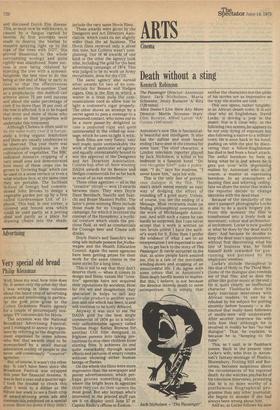Country life
Byways of Chelsea
Dennis Wood
I am becoming more and more case-hardened against the grand spectaculars at the Chelsea Flower Show, and nowadays I prefer to begin by exploring what might be called the by-ways, or side shows. This year I called on the Soil Association and bought two of their leaflets. Make Your Plants Work For You I found fascinating. I already had inklings of a mutual relationship between plants and am this year putting marigolds with my tomato plants, to keep white fly away, but this leaflet contains details of many many more similar plant associations, such as, sage, rosemary and mint planted near cabbages will help to deter the cabbage butterfly and in general herbs planted through the vegetable garden seem to deter insects. The other one, The Value of Weeds, explains what soil conditions are indicated by the appearance of certain weeds, and how many, if not all of them, are much too good to waste and much better used as a mulch or in the compost bin, and some Ulso are perfectly edible. The address of the Soil Association is Walnut Tree Manor, Haughley, Stowmarket, Suffolk.
I picked up the first volume of the Agricultural Research Council's Research Review, a new publication, which should be of interest to farmers and growers. This one has articles on white clover innoculation, research on viruses and the mechanical harvesting of blackcurrants. Under the aegis of the Agricultural Research Council the Long Ashton Research Station put up an exhibit illustrating the comparative usefulness of different kinds of bees in the pollination of fruit, chiefly apple blossom. It appears that solitary bees carry most pollen, followed by bumble bees and followed in turn by hive bees. This is not a true indication of the ultimate effectiveness of these different kinds of bees because there are always very many more hive bees than solitary or bumble bees and their overall efficiency must be the best. It is incidentally quite possible to set up a colony of bumble bees by catching bumble queens and putting them into specially made houses. There was an ingenious piece of demonstrating equipment showing where the best calm conditions prevail behind a windscreen, for example a shelter belt of trees. Best conditions exist at a distance of from 21/2 to 3 times the lineal distance to leeward of the height of the screen above the tops of the crops.
I spoke to the Southern Tree Surgeons of Crawley Down, Sussex and discussed Dutch Elm disease. This, as must now be well known, is caused by a fungus carried by beetles. At first attempts were made to destroy the beetles by massive spraying right up to the tops of the trees with DDT; this proved disastrous to the whole surrounding ecology and quite rightly was abandoned. Some success is now being obtained by injecting the tree with a systemic fungicide, the best time to do this being at the end of May or early in June so that the effectiveness persists well into the summer. Used as a prophylactic this method can achieve about 75 per cent success and about the same percentage of cure if no more than 10 per cent of the tree is affected. It is to be hoped that more and more of those who have elms on their properties will undertake this treatment.
Although Chelsea is often said to he the same every year it is fortunately a living organic institution and there are usually tendencies to be observed. This year there was unmistakable emphasis on the cultivation of vegetables. The BBC indicated intensive cropping of a very small area and demonstrated how many of these crops can be grown in 'Growing Bags' which can be used on a stone terrace or even a wide window box; at the same time they are portable. The Inchbald School of Design had commissioned John Brooks to design a vegetable garden put up by a firm called Gardenesque Ltd. of Liphook. This had, in one corner, a covered and fenced area which could be used partly as a potting shed and partly as a place for drawing chairs into the shade.



























 Previous page
Previous page